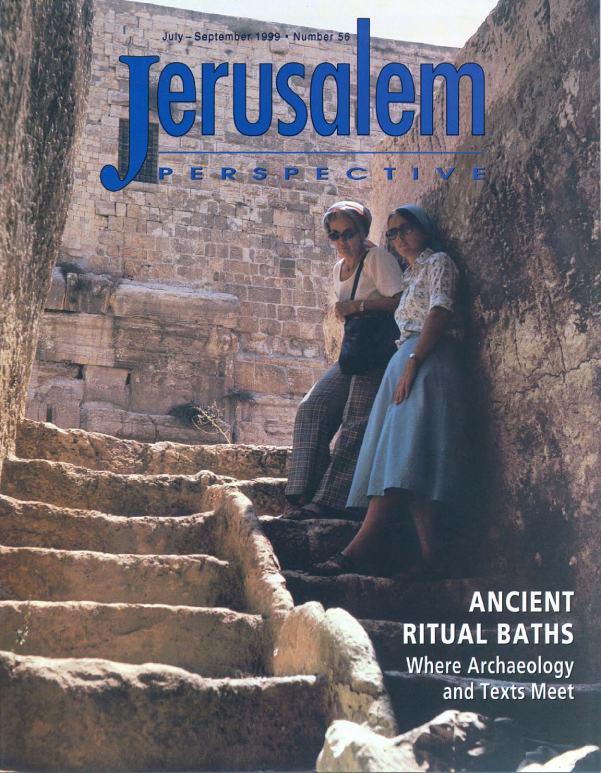How to cite this article: David N. Bivin, “The New International Jesus,” Jerusalem Perspective 56 (1999): 20-24 [https://www.jerusalemperspective.com/5197/].
Revised: 6 June 2023
The New Testament writer Luke described both Jesus and Paul as speaking in Hebrew (Acts 21:40; 22:2; 26:14). In all three places, however, translators of the New International Version rendered the Greek word Ἑβραΐς (Hebra’is) as “Aramaic.”[1] Liberties with the text require explanation, so they supplied these notes: “Or Hebrew” at 26:14, and “Or possibly Hebrew” at 21:40 and 22:2. To reflect more accurately the Greek, they would have done better to translate Hebra’is as “Hebrew.” If, then, concluding that such a translation might mislead the reader, they could have added a note expressing their concern, for example: “The Greek text literally reads ‘Hebrew,’ but many scholars think that most first-century Jews in the land of Israel spoke Aramaic; therefore, the reader should interpret ‘Hebrew’ to mean ‘Aramaic.’”[2]
| Rather listen instead? |
| JP members can click the link below for an audio version of this essay.[*] Paid Content If you do not have a paid subscription, please consider registering as a Premium Member starting at $10/month (paid monthly) or only $5/month (paid annually): Register One Time Purchase Rather Than Membership  |
The NIV Study Bible does offer an explanation for the word “Aramaic” in Acts 21:40: “More likely Aramaic than Hebrew, since Aramaic was the most commonly used language among Palestinian Jews.” On the word “Aramaic” in Acts 22:2, it again comments: “Actually, if he [Paul] had spoken in Hebrew, they [the crowd] would have become quieter in order not to miss a single word, because it would have been more difficult for them to understand.”
This argument based on the crowd’s relative silence seems a bit forced. When Paul motioned with his hand to the people, there was “a great silence” (Acts 21:40). When he began to speak in the “Aramaic” language, they became quieter (Acts 22:2). Had he spoken in Hebrew, according to The NIV Study Bible commentator Lewis Foster, the people would have become even quieter. How can one know how much quieter than quiet the people could have become? A more natural explanation would be that the people settled down when Paul motioned to them, and they became silent the moment he began to speak.
The NIV translators also rendered the adverb Ἑβραϊστί (Hebra’isti) as “in Aramaic” in John 5:2; 19:13, 17, 20; and 20:16. The Johannine verses have no accompanying notes to indicate that the Greek adverb may mean simply “in Hebrew.”[3] Interestingly, however, they rendered Hebra’isti as “in Hebrew” in Revelation 9:11 and 16:16. Here the Greek allowed no other option, since Abaddon (9:11) and Harmagedon (16:16) can only be the transliterations of Hebrew and not Aramaic words.
Paid Content
Premium Members and Friends of JP must be logged in to access this content: Login
If you do not have a paid subscription, please consider registering as a Premium Member starting at $10/month (paid monthly) or only $5/month (paid annually): Register
One Time Purchase Rather Than Membership
Rather than purchasing a membership subscription, you may purchase access to this single page for $1.99 USD. To purchase access we strongly encourage users to first register for a free account with JP (Register), which will make the process of accessing your purchase much simpler. Once you have registered you may login and purchase access to this page at this link:

| [*] Music in the Audio JP files is excerpted from the Hebrew song Moshe written by Immanuel Zamir in a recording sung by Yaffa Yarkoni obtained from Wikimedia Commons. |

- [1] The New International Version is copyrighted by the International Bible Society and published by Zondervan Bible Publishers. ↩
- [2] A number of versions have marginal notes explaining that “Hebrew” refers to “Aramaic” (e.g., New American Standard: “Jewish Aramaic”; New Berkeley Version: “The language was the colloquial Aramaic that was used by the Jews of that period” [Acts 21:40]), but very rarely have Bible translators inserted the word “Aramaic” into the text. ↩
- [3] With three exceptions (note the following paragraphs), none of the major English versions, beginning with the Authorized Version of 1611, has rendered Hebra’is and Hebra’isti in John 5:2; 19:13, 17, 20; 20:16; Acts 21:40; 22:2 and 26:14 as “Aramaic” and “in Aramaic.” The New International Version stands out in this respect. The following twenty-eight versions have rendered Hebra’is and Hebra’isti as “(in) Hebrew,” “(in) the Hebrew tongue,” “(in) the Hebrew language,” and “(in) the Hebrew dialect”: Authorized Version (King James Version); American Standard Version; Revised Standard Version; New King James Version; New American Standard Bible; New Revised Standard Version; The New English Bible; The Jerusalem Bible; New Jerusalem Bible; The Modern Language Bible: The New Berkeley Version in Modern English; The Bible: An American Translation (NT: Goodspeed); The New American Bible; The Bible: A New Translation (Moffatt); The Amplified Bible; The Living Bible (Taylor); The Holy Bible: New Century Version; The New Testament in Modern English (Phillips); The New Testament in Modern Speech (Weymouth); Good News for Modern Man (Bratcher); Good News Bible; The Message: The New Testament, Psalms and Proverbs (Peterson); The New Testament: A Private Translation in the Language of the People (C. B. Williams); The New Testament: A New Translation in Plain English (C. K. Williams); The Simple English Bible: New Testament; The New Testament: A New Translation (Barclay); Jewish New Testament (Stern); Jesus: The four Gospels, Matthew, Mark, Luke and John, combined in one narrative and rendered in modern English (Templeton); The Four Gospels: A New Translation (Torrey).
One version’s skewed handling of Acts 21:40, 22:2 and 26:14 is even more pronounced than the NIV’s: The New Living Translation, published jointly by the International Bible Society and Tyndale House Publishers in 1996, rendered Acts 21:40 as “in their own language, Aramaic,” with the note: “Or Hebrew.” It rendered Acts 26:14 as “in Aramaic,” with the note: “Or Hebrew.” It rendered Acts 22:2 as “in their own language,” with the note: “Greek in Aramaic.” This note renders the NLT’s readers a disservice since the Greek text does not say “in Aramaic,” but rather, “in Hebrew”!
The Simple English Bible: New Testament (American edition), whose English vocabulary includes only 3,000 words, was published by the International Bible Translators in 1981. Except for Rev. 9:11 and 16:16 (“in Hebrew”; “in the Hebrew language”), the SEB rendered the occurrences of Hebra’is and Hebra’isti in the New Testament as “(in) the Aramaic language” or “in Aramaic” (John 5:2; 19:13, 17, 20; 20:16; Acts 21:40; 22:2; 26:14). Only in two of these eight instances (Acts 22:2; 26:14) was a note of justification provided. To the translation “in Aramaic” in Acts 22:2, this note was appended: “the native language of the Jews.” To the translation “in the Aramaic language” in Acts 26:14, this note was added: “The Jews had a special reverence for their native language.”
A third case of translation that runs counter to the Greek text is found in David H. Stern’s Jewish New Testament (1989). Stern, who usually rendered Hebra’is and Hebra’isti as “(in) Hebrew,” three times translated these words “in Aramaic” (John 5:2; 19:13, 17). It is unusual that in these instances he did not feel the need to justify his rendition with a note informing the reader that the Greek reads “in Hebrew.” The reader has been left to believe that in these places the Greek text actually reads Sūristi (in Aramaic). ↩
































































































